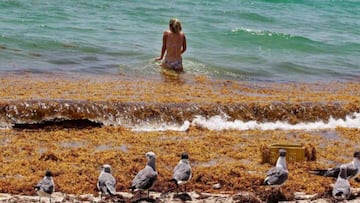What is sargassum, the giant belt of seaweed that is circling Florida
A giant belt of seaweed is migrating westward, threatening beaches in Florida, Mexico’s Yucatan Peninsula, and the eastern Caribbean. What is sargassum?

Key West, Florida is seeing large piles of sargassum on its shores, restricting access to its beaches. The seaweed is part of a belt that stretches over 5,000 miles and circles the Gulf of Mexico and the mid-Atlantic.
The giant belt of sargassum circling Florida is part of a natural phenomenon that has been occurring in recent years. It is a massive floating patch of seaweed that extends from the West African coast to the Gulf of Mexico.
The Great Atlantic Sargassum Belt has been increasing in size and migrating westward due to various factors including ocean currents, climate change, and runoff from agricultural and urban areas.
What is sargassum?
Sargassum seaweed is a type of brown algae that provides an important habitat for a variety of marine life, including fish, birds, shrimp, crabs, and turtles. In the open sea, where they grow in large floating mats or clumps, sargassum can absorb carbon dioxide from the atmosphere, improving habitability.
The seaweed itself is not harmful to humans, but it can cause problems for marine ecosystems and local economies, particularly those that are dependent on tourism.
The problem with sargassum
When the seaweed washes up on the shore, it can cause beach closures and foul odors that can deter tourists. Sargassum begins to rot after about two days on land, and the resulting odor is similar to manure or rotten eggs.
Massive amounts of seaweed can also harm marine life by depleting oxygen levels in the water, smothering coral reefs, and wreaking havoc on the water’s pH balance.
READ ALSO:
The growth of the sargassum belt
The seaweed is believed to have been growing in the Sargasso Sea, a region of the Atlantic Ocean, for thousands of years. However, the recent phenomenon of large amounts of sargassum blooms and patches along the American Atlantic coast has been observed since 2011.
That year, a particularly large belt of sargassum appeared in the central Atlantic and was swept by currents to the Caribbean, the Gulf of Mexico, and the U.S. southeastern coast. Large blooms of the seaweed have formed every year since then, with varying sizes.






